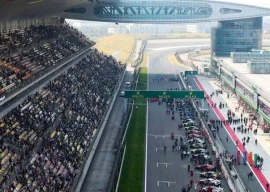
The more development budgets are spent in Pakistan, the more it causes regional disparities. The share of the pie in the national kitty is determined according to the pitch of voices and strength of muscles. Those with strong voices and strong muscles tend to acquire more resources. Therefore, the national and provincial development imperatives are devoid of the actual needs of backward areas.
The 7th NFC award vertically distributes resources as 42.5% share of the federal government and 57.5% shared for the four provinces. The size of the federal Public Sector Development Programme (PSDP) in 2017-18 is Rs1,001 billion, while for the four provinces the combined Annual Development Programmes (ADPs) is Rs1,112 billion. The provinces distribute Rs1,112 horizontally under the NFC award, which is mainly based on population, backwardness, area and revenue generating capacity of the provinces.
The federal government is spending Rs1,001 billion under 2017-18 PSDP throughout Pakistan. When this Rs1,001 billion are spent, Pakistan will have more geographical disparities compared to 2016-17. Take for example Rs33 billion allocated to the communication division. There are a total of 95 projects budgeted under 2017-18 PSDP, only one is for Fata (construction of Bajaur/Khar, Jandola, Zob link road) costing Rs250 million. Similarly, out of a total Rs35 billion allocation for higher education in 2017-18 PSDP, Fata has only Rs250 million for Fata University and Rs300 million for provision of higher education opportunities to both Fata and Balochistan students. That’s all for higher education in Fata and the same pattern goes almost in all sectors.
However, there are ministries which represent specific geographical areas as well. The federal Ministry of States and Frontier Regions (Safron) and the Ministry of Kashmir Affairs and Gilgit- Baltistan are allocated the Federally Administered Tribal Areas (Fata) and Kashmir and Gilgit-Baltistan development budgets, respectively. Fata has been allocated up to Rs24.5 billion for the Annual Development Programme (ADP) in the current fiscal, depicted in the Safron ministry’s development budget. However, this amount is always susceptible to political expediency of the federal government. The case in point is Raja Pervaiz Ashraf spending Fata ADP in his constituency when he became prime minister of Pakistan after Yousaf Raza Gilani was deposed in June 2012.

Raja Pervaiz Ashraf took Rs4 billion from Fata ADP 2012-13 to use it as discretionary funds in his constituency. Unlike provinces, whose share can’t be reverted to the federal government, the budgets of Fata, Kashmir and G-B are under the tight grip of the federal government and their development budgets can be taken away anytime on the pretext of lapses.
The federal government in dealing with provinces and with ‘special areas’ under PSDP can’t be justified under the existing system of discretionary funds at the disposal of prime minister. Similarly, the provinces’ economic dealing with the respective districts under ADP is dreadful. Provinces are supposed to allocate equitable budgets to all districts under their respective Provincial Finance Commission (PFC) awards and ADPs. Unfortunately, the PFC awards are either not devised or not fully implemented. In the last fiscal year, Lahore district was allocated Rs134 billion (58%) out of total Rs229 billion districts-based allocations. Similarly, in K-P major portion of the ADP goes to those ‘elites’ districts where the political bigwigs reside. As media reports show, the Khyber-Pakhtunkhwa government spent 47% of ADP (Rs57.78 billion) in fiscal year 2016-17 in Peshawar district only.
Some 74% of the total ADP in the last fiscal year was spent in seven districts inhabited by the political elite. These districts are Peshawar, Mardan, Charsadda, Nowshera, Swat, Dera Ismail Khan and Swabi. These are the comparatively developed districts of K-P. The most under-developed districts in K-P are Tor Ghar, Tank, Hangu, Kohistan, Buner, Lakki Marwat and Battagram and these districts got the lowest share in the previous year ADP. In the whole Tor Ghar district, there is not a single girls’ high school. Yet, the development funds go to Nowshera district, the constituency of the chief minister of K-P, for establishing universities.
The federal and provincial governments should allocate budgets on the actual needs for reducing geological disparities in development. The practice of block allocation and discretionary funds at the disposal of PM and CMs should be discarded. Fata and K-P may merge soon and K-P’s share in the NFC award may increase further, but who will ensure that the South Waziristan, North Waziristan, Orakzai, Bajaur, Mohmand, Khyber, and Khurram districts, Fata’s agencies now, are not treated as Tor Ghar and Tank districts of the K-P province?
Published in The Express Tribune, November 4th, 2017.
Like Opinion & Editorial on Facebook, follow @ETOpEd on Twitter to receive all updates on all our daily pieces.

















1713268762-0/Netflix-(3)1713268762-0-270x192.webp)


1713264570-0/Tribune-Collage-Feature-Images-(9)1713264570-0-270x192.webp)























COMMENTS
Comments are moderated and generally will be posted if they are on-topic and not abusive.
For more information, please see our Comments FAQ